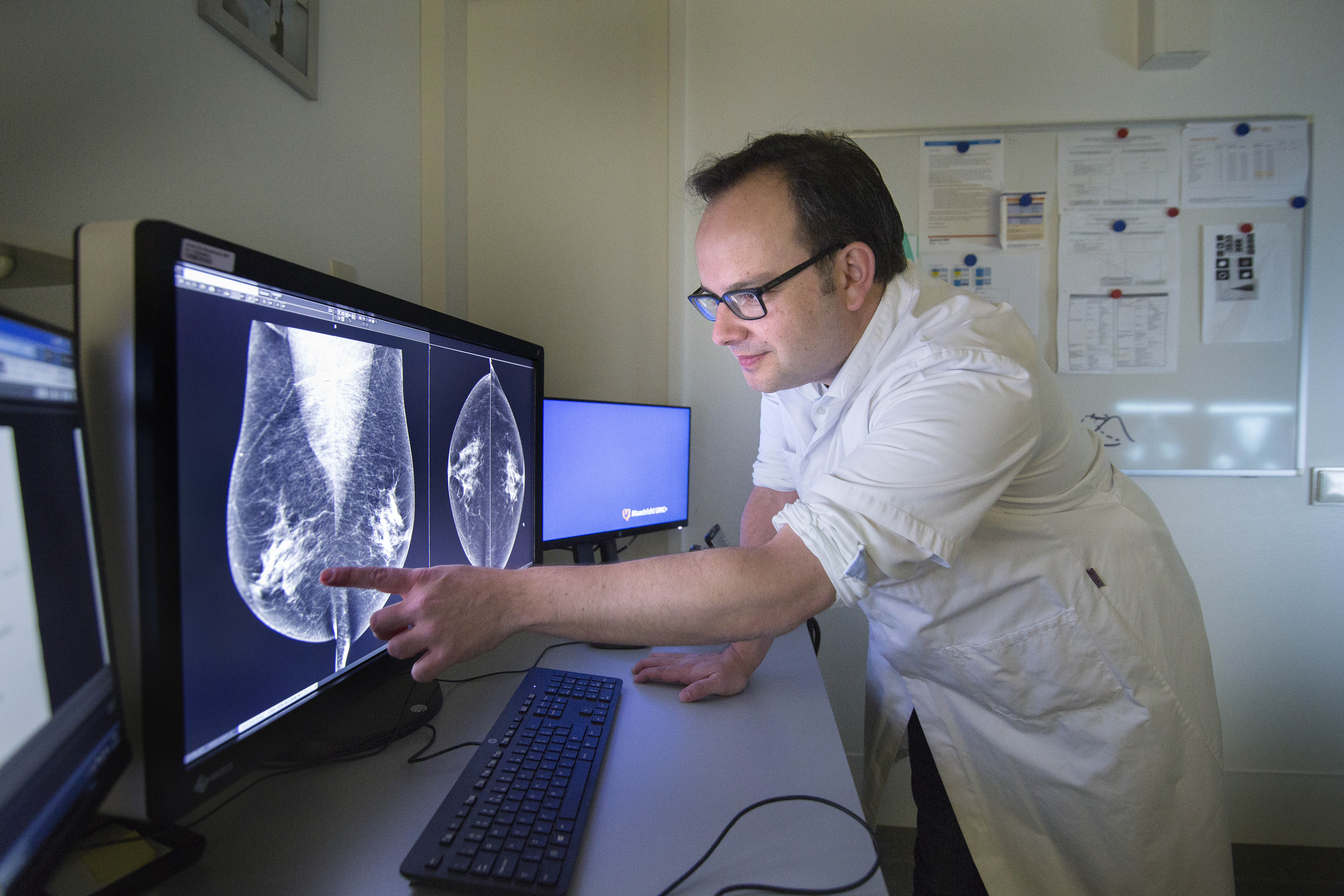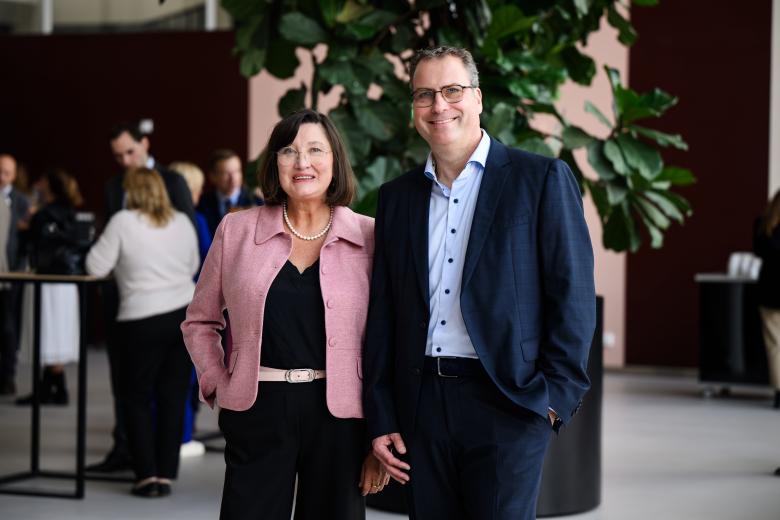“A contrast mammogram delivers significantly better images”
Radiologist Marc Lobbes is a specialist in breast radiology. While still training with internationally renowned professor Carla Boetes, from one moment to the next he became, as a 34-year-old doctor, responsible for the mammography department at Maastricht UMC+ when she died in 2011. Six years later, the mammography department of Maastricht UMC+, thanks to Lobbes and the team of breast specialists, is considered highly advanced in the detection of breast cancer.
The crown jewel with which Maastricht UMC+ distinguishes itself from other hospitals is the Contrast Enhanced Spectral Mammography (CESM), also known as contrast mammography. “It’s a technique in which we do a mammogram after administering contrast fluid. This type of mammogram provides significantly better diagnostic results than the traditional mammogram, which allows radiologists to more accurately determine whether or not breast cancer is present”, Lobbes explains. Maastricht UMC+ was the first hospital in the Netherlands to use this innovative method. Thanks to this relatively new technique, a patient’s anxiety can be eliminated faster, resulting in valuable time savings. Lobbes: “This allows us to determine, with almost 100 per cent accuracy, that someone doesn’t have a tumour if the CESM scan fails to show any abnormalities. There’s no need to schedule additional procedures or unnecessary follow-ups.”

Distress and uncertainty
Not all women who come to Maastricht UMC+ for a mammogram because of a suspicious lump in their breast are examined using this new technique, Lobbes explains. Although the method is safe, some patients may have an allergic reaction to the contrast fluid. “So far, we’re using this examination method almost exclusively with women referred to us from the breast cancer population screening because of a suspected malignancy. That’s about 250 women per year. A referral from the population screening often causes a lot of distress and uncertainty that later proves to be unnecessary”, says Lobbes. “To prevent this, it’s important to provide a final diagnosis as quickly and reliably as possible. Contrast mammography contributes significantly to this.”
According to the radiologist, almost three-quarters of the women who come to Maastricht UMC+ through the population screening don’t appear to have breast cancer but a harmless abnormality. There are plans to also use contrast mammography in the near future for (often young) women with excessive and dense glandular tissue. “With this group, an ordinary mammogram doesn’t always provide a definitive diagnosis.”
MRI technology
With the women who are not yet eligible for a contrast mammogram, Maastricht UMC+ also uses MRI imaging. “That’s the legacy of Professor Carla Boetes from whom I learned this specialty”, says Lobbes. “She was a strong advocate of using an MRI. Trained by her, I look at MRI images in a very specific way, not only by detecting but also by primarily interpreting what I see. According to Carla, I was a natural at mammography. I share her opinion that a good radiologist not only sees if an image contains an abnormality, but also succeeds in placing it in a broader context, as multiple specialties are involved in breast cancer care.”
Trust
The day Lobbes heard that his mentor and role model had died, he still remembers in detail. “On Friday afternoon, she had wished everyone a nice weekend, and when I got to my desk on Monday, there was the shocking news of her death. I was still working toward a specialisation to become a mammogram radiologist and hadn’t graduated yet. I felt unsure. How should I proceed? What would be expected of me? Partly because of the trust I received from our current department head, Joachim Wildberger, I quickly grew into my new role as a staff member.”
Greater recognition
Carla Boetes was recruited to Maastricht UMC+ a few years before her death, to bring greater recognition to the mammography department. Lobbes was the first to be able to intern with her. “Carla was an extremely friendly person with whom I immediately clicked. I saw it as a huge privilege to be able to tag along with and observe someone of that calibre every day.”
Suspicious lymph nodes
Lobbes and his colleagues are now working on a study that focuses on the application of MRI without administering contrast agents, in order to make the research available for the national screening. “Another development resulting from this is that we’re increasingly using the PET-MRI scanner to diagnose suspicious lymph nodes in the underarm. The purpose of this is to accurately determine the nature of the abnormality in the underarm and possibly prevent an additional surgery for a woman with breast cancer. The main advantage is that we don’t need to unnecessarily remove all of the lymph nodes, which can prevent complications in the patient’s arm and shoulder.”
Although Lobbes does not come from a family of physicians—his father was a bank worker, his mother housewife—he knew he wanted to become a doctor by the time he was 15. He initially planned to become a neurologist, and he realised after he had already been studying neurology for several months, that his heart was more in radiology. “This proved to be the right choice, and I’m conscious of that every day.”
Also read
-
Steel tariffs explained: Why is the EU doubling them — and at what cost?
The EU announced last week that it would double its tariffs on steel to 50 percent, bringing them in line with US levels. Studio Europa Maastricht spoke with Mark Sanders, Associate Professor of International Economics at Maastricht University about the latest developments surrounding the increase...

-
ERASMUS+ - free movement of ideas and skills
Under ERASMUS+, the European Commission's mobility programme for education and training, UM sends and receives more students than any other Dutch university. President Rianne Letschert on her own ERASMUS experience, the benefits of leaving your comfort zone, and being inspired by different...

-
WHO designates two CAPHRI centres as new Collaborating Centres for Public Health Leadership and Workforce Development
With these centres, WHO wants to advance the professionalisation and competencies of the public health workforce.
